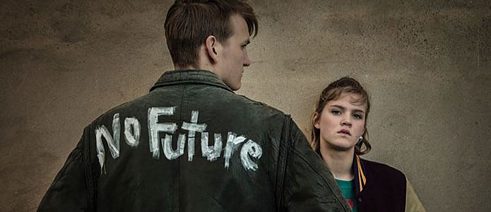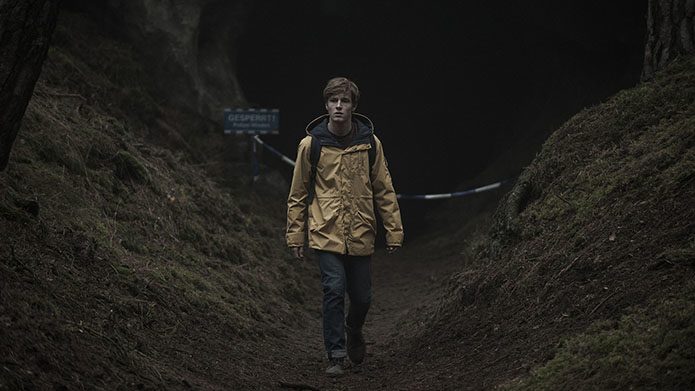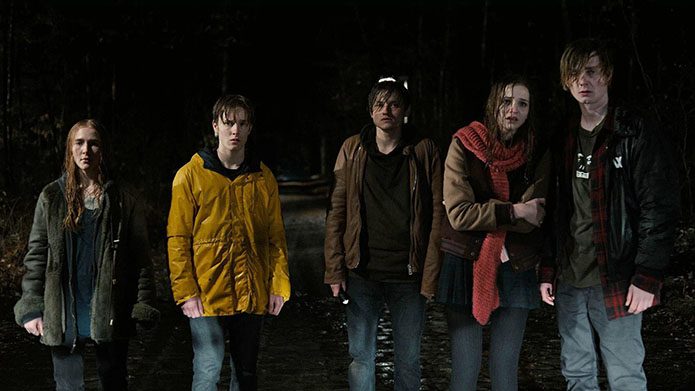Netflix’s ‘Dark’
Small-town moods, mysteries and metaphors

© Netflix
The woods outside of Winden are full of secrets. The houses inside of the town, the nuclear power plant sitting on its borders and the labyrinthine caves beneath it, too. In Netflix’s first German-language original series ‘Dark’, mystery blankets the air as thick as the persistent fog; however this is a place haunted by more than everyday intrigue.
Where deep-seeded inner turmoil, a fraying community, and the impact of the past upon the present and future all meet, that’s where this crumbling fictional locale, and the compelling show about it, both exist.
People, places, times and spaces
Created by Baran bo Odar and Jantje Friese, written by the duo with three co-scribes contributing to three episodes, and directed solely by bo Odar, Dark finds its twisty tale in four interconnected families, a number of different time periods and many unspoken matters. The ten-part first season begins with a suicide in 2019, then uses grieving high-schooler Jonas Kahnwald (Louis Hofmann) as an entry point into Winden’s murky reality, before charting the bonds between several missing boys across the course of decades.Returning to class after seeking medical assistance following the death of his father, Jonas is trying to immerse himself back in normality, until an evening jaunt through the forest with his friends results in a town-wide search for suddenly disappeared pre-teen Mikkel Nielsen (Daan Lennard Liebrenz). Coming just weeks after another boy went missing, the locals react with the expected fear, force and anxiety. For Mikkel’s police officer father Ulrich (Oliver Masucci) — who happens to be having an affair with Jonas’ widowed mother Hannah (Maja Schöne) — the situation also drudges up memories of his own younger brother, who went missing in eerily similar circumstances in 1986.
Police chief Charlotte Doppler (Karoline Eichhorn) is on the case, while also noticing that birds keep falling from the sky and grappling with her own difficulties at home. Jonas’ best friend Bartosz Tiedemann (Paul Lux) tries to be supportive, but the fact that he’s now dating Martha Nielsen (Lisa Vicari) — Mikkel’s older sister and Jonas’ crush before his hospitalisation — complicates matters. And then there’s the stranger (Andreas Pietschmann), who appears dedicated to a particular task that involves both the current events and those 33 years prior.
Pervasive unease
More characters spring up, as well as multiple versions across different time periods. Links between families, and between decades, only deepen as the series progresses — and, like all of the best mysteries, Dark’s grim intertwined delights are best discovered by watching. The details intrigue and fascinate, teased out as they are with loaded dialogue and pointed reminders about cause and effect, as served up in bite-sized pieces. Indeed, as with most of Netflix’s episodic dramas, Dark’s developments are all structured around cliffhangers designed to keep viewers not just watching but binging.Still, the series’ narrative only comprises part of Dark’s enticing allure — a feeling that is so aptly described by the show’s title that no other term could come close to doing it justice. Watching closely, noting connections, puzzling together pieces and guessing what comes next are part of any program that trades in twists, but the mood that Dark cultivates assists immensely in deepening its appeal. An atmosphere of insidiousness, of ominousness, of ill portent, pervades the series; one that needles at its viewers like Ben Frost’s purposefully bombastic and unsettling score. And, while bo Odar’s stylistic choices are rarely subtle, they’re always effective.
 The woods outside of Winden are full of secrets.
| © Netflix
Indeed, the use of mirrored shots, split-screen compositions that contrast the same characters in different eras and repeated angles all reinforce Dark’s air of unease, each slickly deployed instance at a time. The show’s gloomy colour scheme and lighting choices also help, with everything couched in dimness and despair as though the alternatives of brightness and hope simply aren’t possible. Given that the series is filled with lost kids, marital infidelity, shattering secrets, dead animals, risky experiments and horrific murders, the bleak tone and accompanying hues are as apt as they are unsurprising. The cumulative impact is, by intention, inescapable; in case the distressed expressions worn by the entire cast didn’t convey enough strain, every other aesthetic aspect of the show is calculated to seethe with tension.
The woods outside of Winden are full of secrets.
| © Netflix
Indeed, the use of mirrored shots, split-screen compositions that contrast the same characters in different eras and repeated angles all reinforce Dark’s air of unease, each slickly deployed instance at a time. The show’s gloomy colour scheme and lighting choices also help, with everything couched in dimness and despair as though the alternatives of brightness and hope simply aren’t possible. Given that the series is filled with lost kids, marital infidelity, shattering secrets, dead animals, risky experiments and horrific murders, the bleak tone and accompanying hues are as apt as they are unsurprising. The cumulative impact is, by intention, inescapable; in case the distressed expressions worn by the entire cast didn’t convey enough strain, every other aesthetic aspect of the show is calculated to seethe with tension.
What lurks within
Of course, from the supernatural scares of Stranger Things to the wrapped-in-plastic quirkiness of Twin Peaks, exploring the horrors of small-town life is far from a new occurrence in episodic television. Comparisons between Dark and both of the aforementioned shows are rife and fitting, with examining how the woes of such insular communities can represent and reflect existential turmoil proving another common thread throughout the small-town mystery genre. What Dark embodies, like its predecessors before it, is a relatable concern: that the worries eating away at all of us can come to life. More than that, it demonstrates how the worst things that we can imagine can materialise even in supposedly safe confines.Dark couches its storyline in time jumps, coincidences that might be something more, unnerving parallels and disquieting patterns, but it is first and foremost a study in inner stress and anxiety. From Jonas’ father’s decision to end his life, to the blank-eyed stare Jonas himself brandishes as his world crumbles several times over, to the unhappiness painted across every face in Winden — in 2019 and 1986 alike — there’s nary a cosy, content moment to be seen across its ten episodes, and not just as a result of external forces. In fact, the script goes to great lengths to explain how every ostensibly isolated detail links to something else, is sparked by a connected choice and, crucially and heartbreakingly, springs from someone’s misery. A wicked web is weaved not just from ongoing traumas that tear the town apart incident by incident, but by the fears they represent.
 The series’ narrative only comprises part of Dark’s enticing allure — a feeling that is so aptly described by the show’s title that no other term could come close to doing it justice.
| © Netflix
What is the absence of children — more than that, the taking and killing of children — if not the absence of a future? What does the fraying of a marriage, friendship or working partnership illustrate, if not the dismantling of the ties of trust and loyalty that bind humanity together? What is a cavernous underground maze if not the literal embodiment of the buried end that awaits us all? What does the repetition of events and outcomes demonstrate if not a lack of choice, control and agency? In Dark, a winding mystery that joins people, places, times and spaces together in inventive ways becomes, bit by bit, an exploration of everyday, relatable, commonplace concerns writ large with horror and science fiction. As the series delves into what lurks within on many levels, it also serves up a gripping foundation for further chapters, with a second season already announced.
The series’ narrative only comprises part of Dark’s enticing allure — a feeling that is so aptly described by the show’s title that no other term could come close to doing it justice.
| © Netflix
What is the absence of children — more than that, the taking and killing of children — if not the absence of a future? What does the fraying of a marriage, friendship or working partnership illustrate, if not the dismantling of the ties of trust and loyalty that bind humanity together? What is a cavernous underground maze if not the literal embodiment of the buried end that awaits us all? What does the repetition of events and outcomes demonstrate if not a lack of choice, control and agency? In Dark, a winding mystery that joins people, places, times and spaces together in inventive ways becomes, bit by bit, an exploration of everyday, relatable, commonplace concerns writ large with horror and science fiction. As the series delves into what lurks within on many levels, it also serves up a gripping foundation for further chapters, with a second season already announced.Season 1 of Dark screens on Netflix.